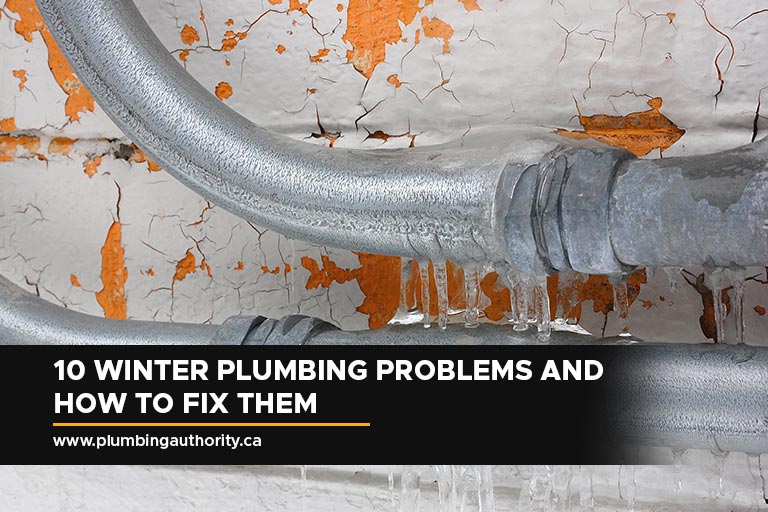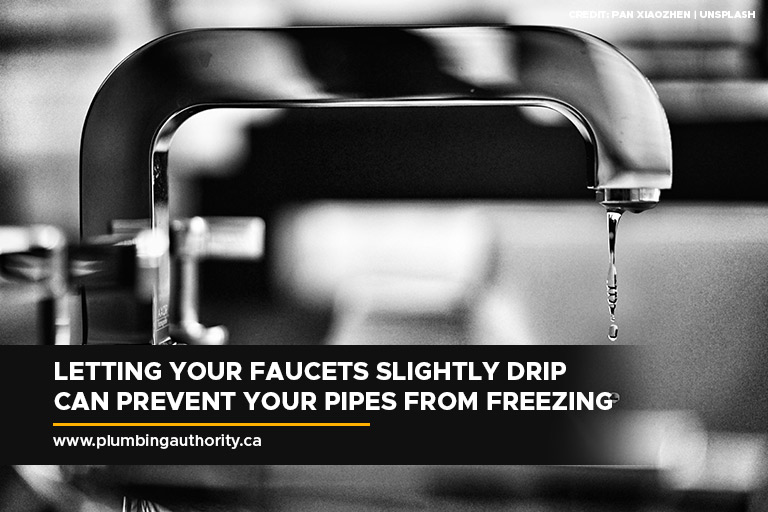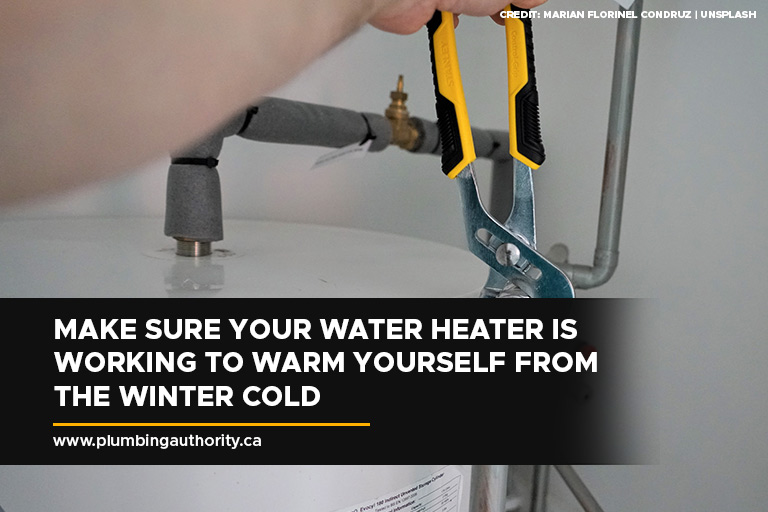
Winter weather can cause numerous problems for residents of Canada. During the winter, homes are susceptible to plumbing problems, causing homeowners to panic as they attempt to protect their properties from harm. The majority of plumbing problems experienced during the winter may be avoided with regular maintenance and planning or quickly fixed using standard plumbing troubleshooting methods.
In this article, we will examine the top 10 plumbing problems that typically arise in the winter, and offer advice on how to avoid and efficiently fix them.
Winter Plumbing Problems

- Letting your faucets slightly drip can prevent your pipes from freezing
Frozen Pipes
Frozen pipelines are one of the most prevalent winter plumbing issues. When water freezes inside pipelines, it can potentially cause them to expand and burst. This can result in water leakage and extensive property damage.
Solution:
- If you leave the faucet open, water can flow through the pipe and help thaw it faster.
- Try using a hair dryer or an electric heating pad to warm the area around the conduit. If neither of these items is available, hot-water-soaked towels will suffice.
- Once the pipe has been successfully thawed, examine other faucets in your home for additional frozen water pipes.
Burst Pipes
Frozen pipes directly cause burst pipes, which can result in substantial water damage if not addressed immediately. The ice then expands and pushes the water toward the faucet, resulting in a significant buildup of pressure between the ice blockage inside the conduit and the faucet.
Solution:
- Leave the faucets running to completely discharge the pipes release any remaining pressure, and flush every toilet. In certain cases, it may be imperative to deactivate the power source, contingent upon the location of the spillage.
- To ensure the appropriate repair of the conduit, it is advisable to contact a professional plumber. Self-repair of the conduit could cause additional damage, so it is best to rely on professionals.
- Using a wet/dry vacuum, remove as much standing water as possible, transport waterlogged items to a warm, dry location, and install fans or a dehumidifier in the affected area.
Blocked Drains
Winter storms and an increase in indoor activity can clog sewers. Grease, debris, and other substances can accumulate, resulting in clogged drains or sluggish drainage. Regular drain service and refraining from spilling fats and oils down the drain can aid in preventing clogs.
Solution:
- Mould, bacteria, and insects quickly proliferate in stagnant water, so remove it immediately.
- It is recommended to clean the drain by putting table salt into it and then draining it with hot water. If this method fails, an alternative method entails combining equal parts baking soda and vinegar and allowing the resulting mixture to bubble for 15 minutes before pouring hot water down the drain.
- If the obstruction is not visible after removing the P-trap, begin snake cleaning. Spin the serpent counterclockwise down the drain. Continue converting yourself into a snake until you meet resistance and feel the blockage release. Retract the serpent, reassemble the P-trap, and flush the newly opened line with copious amounts of warm water.
Water Heater Issues
During the winter, an electric hot water system may experience strain due to increased consumption.
Solutions:
- Increasing the temperature setting on the timer could be one way to fix the problem of the water heater not producing enough water. Please consider implementing this modification.
- Depending on the type of water heater you have, examine the electrical power or gas supply if your water heater is not working.
- Check the limit switch of the water heater’s thermostat. When water is too hot, the circuit breaker may fail and must be reset.
Leaky Faucets
The rubber seals in faucets can contract in cold weather, leading to leakage. Not only does a dripping faucet wastewater, but it can also contribute to higher utility bills.
Solution:
- Due to cold temperatures and icy pipes, toilets can become readily clogged during the winter. To prevent clogging, you should only flush small quantities of waste at a time.
- It is recommended to maintain a clean restroom during the winter months. This will reduce the likelihood of a pipe blockage caused by buildup.
Clogged Toilets
In winter weather, rubber seals in faucets can contract and cause leaks. A trickling faucet not only wastes water but can also contribute to higher utility costs.
Solution:
- Due to cold temperatures and icy pipelines, winter is a common time for toilets to become clogged. To avoid clogging, you should flush only small amounts of refuse at a time.
- During the winter, it is recommended to maintain a spotless restroom. This will reduce the likelihood of a buildup-caused pipe obstruction.
Frozen Outdoor Faucets
Outdoor faucets are especially susceptible to freezing conditions. In the absence of adequate insulation, they can freeze and potentially rupture. Disconnect and discharge outdoor hoses, and consider protecting outdoor fixtures with faucet covers.
Solution:
- To prevent damage, disconnect hoses, discharge water, and store them for the winter. Inside the residence, close the shutoff valve on the water line serving the faucet. Outside, open the hose bib valve to allow water to escape, and leave it open throughout the winter to relieve pressure if freezing occurs.
- Consider replacing outdoor faucets with frost-resistant hose connectors. These specially designed components assist in preventing icing.
- Add insulation to the water lines that serve the hose bibbs outside your residence.
Lack of Water Pressure
Low water pressure can be caused by frozen pipelines or other plumbing issues during the winter. Ice is not the only object that can restrict the flow of water through your pipes. Mineral or sediment accumulation is another common offender.
Solution:
- Check for icy water lines and thaw them as necessary. The pipelines can be insulated to prevent them from freezing in the first place.
- Scale accumulation is also a potential issue. Water softeners can be used to prevent this from occurring.
- Employ the services of a plumber to detect and fix leakage. Upon completion of the repairs, your water pressure should return to normal.
Basement Flooding from Fast Snow Melt
When snow melts too rapidly due to rising temperatures or precipitation, it can cause flooding on the ground, which can lead to water seepage into your basement. Inadequate water drainage, foundation fissures, and overworked sump pumps can also contribute to flooding.
Solution:
- If your cellar floods due to snowmelt, dry the area as soon as possible to minimize water damage.
- Remove any items with water damage from the cellar.
- Immediately dry the cellar to prevent mould growth. Dehumidifiers and industrial fans can be used to remove moisture and circulate air throughout the space to facilitate drying.
- Once the basement is completely dry, check for water leaks and seal any cracks with caulk or hydraulic cement to prevent future breaches.
Sewer Line Problems
Winter precipitation can overwhelm wastewater lines, causing backups and blockages. Regular sewer line maintenance and avoiding draining non-biodegradable materials can help prevent sewer line issues.
Solution:
- Find the septic tank’s access cover and remove it.
- Find the outlet within the septic tank that connects to the main discharge line of the residence.
- Insert the hose into the outlet of the septic conduit and activate the water supply. Advance the hose until resistance is felt.
- Permit water flow to dissolve the obstruction. You will be able to press the hose further as it melts.
- Once the obstruction has been removed, remove the hose, replace the septic tank cover, and thoroughly sanitize the hose.
Let the Experts Solve Your Winter Plumbing Problems

- Make sure your water heater is working to warm yourself from the winter cold
Hiring a plumber to perform a thorough maintenance inspection on your plumbing system is a wise investment. With their knowledge and expertise, they will be able to immediately identify potential issues and assist you with the repair procedure.
However, you can do your part by reducing the frequency of repair visits and the likelihood of plumbing disruptions by adhering to these maintenance recommendations. Go to Plumbing Authority Inc. for septic tank repairs, installations, and other services in Ontario. We are available to assist at any time you require our support. Please contact us promptly at (647) 992-7473 to arrange a complimentary in-person quotation.




